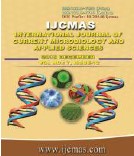


 National Academy of Agricultural Sciences (NAAS)
National Academy of Agricultural Sciences (NAAS)

|
PRINT ISSN : 2319-7692
Online ISSN : 2319-7706 Issues : 12 per year Publisher : Excellent Publishers Email : editorijcmas@gmail.com / submit@ijcmas.com Editor-in-chief: Dr.M.Prakash Index Copernicus ICV 2018: 95.39 NAAS RATING 2020: 5.38 |
In the present study, the effect of five numbers of commercial dahi starter cultures, the changes in pH and tritratable acidity during curdling of milk while dahi making on fate of inoculated pathogens viz.,Escherichia coli AB1157 and Salmonella typhimurium were assessed. Commercial dahi starter cultures namely, NCDC 154, 159, 161, 166 and 91 has been procured from National Collection of Dairy Culture, National Dairy Research Institute, Karnal and utilized for preparing dahi. Dahi prepared by back slopping using culture from students’ boarding house, College of Food and Dairy Technology, Chennai has been kept as control. Results of experiment I revealed that the initial E. coli count in control group was reduced by 2.52 log10cfu/g of milk. Similarly, treatment groups T1 and T4 involving NCDC91 and NCDC161 dahi cultures also recorded reduction in initial count by 0.44 and 0.31 log10cfu/g of samples, respectively. In experiment II, the initial Salmonella typhimurium count did not reduced but increased in control and treatment groups studied. However, this increase in the S. typhimurium count was significantly lower (p≤0.05) in control when compared to treatment groups. This indicates that the developing acidity and reduction in pH had little effect on S. typhymurium growth but was not able to reduce the number of organisms.
 |
 |
 |
 |
 |